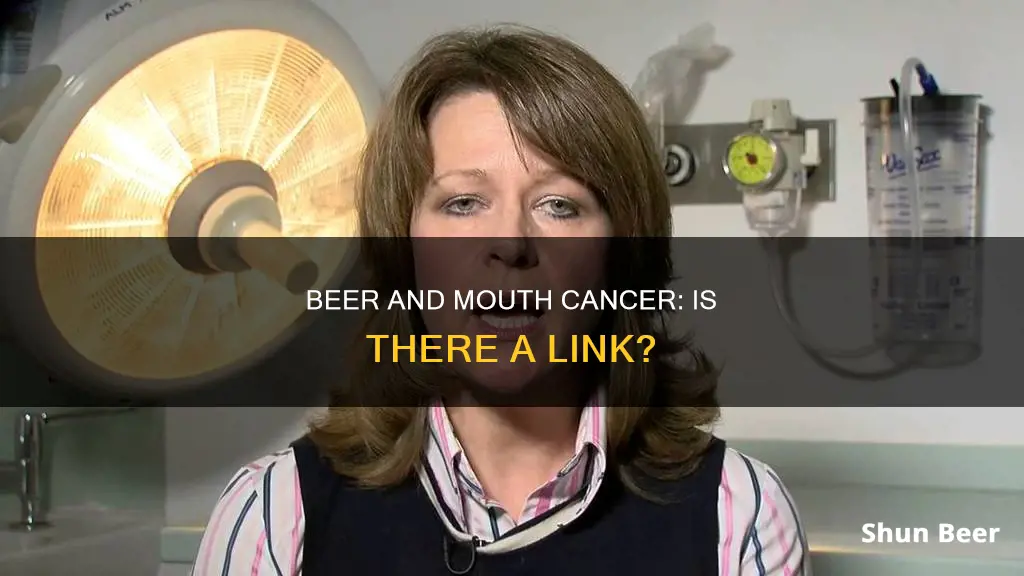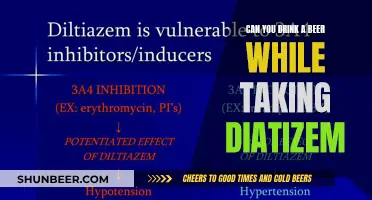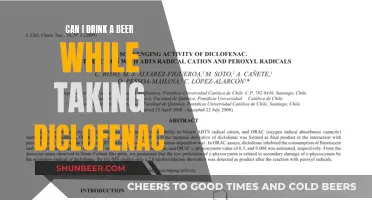
Alcohol is a known carcinogen, and drinking it is linked to an increased risk of several cancers. Alcohol consumption is associated with a higher risk of head and neck cancers, including oral cavity and pharyngeal cancers. The more alcohol a person drinks, the higher their risk of developing alcohol-associated cancer.
Alcohol is broken down by the body into acetaldehyde, a known carcinogen that damages DNA and prevents cells from repairing this damage, allowing cancerous cells to grow. Alcohol also affects hormone levels, particularly oestrogen, which acts as a messenger that tells cells to grow and divide, increasing the chances of cancer developing.
Alcohol abuse, defined as consuming more than 21 standard drinks in a week, is the second-largest risk factor for oral cancer. Alcohol dries out the skin of the mouth, making it more porous and allowing tobacco toxins to pass through more easily. It is also broken down by bacteria in the mouth to make cancer-causing chemicals.
Additionally, heavy drinking can lead to nutritional deficiencies, making it harder for the body to absorb nutrients that protect against cancer, such as vitamins A, B1, B6, C, D, E, K, and folate. Poor diet is also a risk factor for mouth cancer, and many people who drink large amounts of alcohol neglect their diet.
The combination of drinking alcohol and smoking increases the risk of mouth cancer by about 30 times. This is because alcohol and tobacco smoke contain similar poisonous chemicals, acetaldehyde and formaldehyde, which can overwhelm the body's defence mechanisms.
While moderate drinking may be a part of a healthy lifestyle for some, it's important to be aware of the risks associated with excessive alcohol consumption.
| Characteristics | Values |
|---|---|
| Alcohol consumption and mouth cancer | Alcohol is a common term for ethanol or ethyl alcohol, a chemical substance found in alcoholic beverages such as beer, hard cider, malt liquor, wines, and distilled spirits (liquor). Alcohol consumption is linked to an increased risk of mouth cancer. |
| --- | --- |
| How alcohol causes cancer | Alcohol is broken down by the body into acetaldehyde, a known carcinogen that damages DNA and stops cells from repairing the damage, allowing cancerous cells to grow. Alcohol can also affect the levels of hormones like estrogen, which act as messengers that tell cells to grow and divide, increasing the chances of cancer development. |
| Alcohol and tobacco | People who use both alcohol and tobacco are at a higher risk of mouth cancer. Alcohol and tobacco have a combined effect that causes greater damage to cells. Alcohol may also make it easier for cells in the mouth to absorb harmful chemicals found in tobacco smoke. |
| Alcohol intake and mouth cancer risk | Excessive drinking, or more than 21 standard drinks in one week, is the second-largest risk factor for mouth cancer. |
What You'll Learn
- Alcohol abuse is the second-largest risk factor for oral cancer
- Alcohol dehydrates the mouth, allowing tobacco toxins to pass through more easily
- Alcohol is broken down into cancer-causing chemicals in the mouth and body
- Alcohol increases the risk of mouth cancer by 30 times when combined with tobacco
- Excessive alcohol consumption is linked to poor diet, another risk factor for mouth cancer

Alcohol abuse is the second-largest risk factor for oral cancer
The consumption of alcoholic beverages has been linked to an increased risk of several types of cancer. Alcohol is a known human carcinogen, and the more alcohol a person consumes, the higher their risk of developing an alcohol-associated cancer. Even those who have no more than one drink per day and binge drinkers have a slightly increased risk of some cancers. Moderate drinkers have 1.8 times the risk of oral cavity and pharynx cancers compared to non-drinkers, while heavy drinkers have a five times higher risk.
The combination of alcohol and tobacco use has a multiplicative effect on the risk of oral cancer. The risk of oral cancer in people who drink heavily and smoke is about 30 times higher than in those who abstain from both. This is because alcohol and tobacco synergistically interact, increasing each other's harmful effects.
Alcohol's impact on the development of oral cancer may be related to its dehydrating effect on cell walls, making it easier for tobacco carcinogens to penetrate mouth tissues. Additionally, heavy drinking can lead to nutritional deficiencies that impair the body's ability to use antioxidants to prevent cancer formation.
It is important to note that alcohol abuse is not the only risk factor for oral cancer. Tobacco use, human papillomavirus (HPV) infection, ultraviolet (UV) light exposure, and poor oral hygiene have also been implicated as risk factors. However, alcohol abuse remains a significant contributor to the development of oral cancer, and reducing or eliminating alcohol intake can immediately lower the risk of oral cancer.
Mixing Beer and Gin: A Match Made in Heaven?
You may want to see also

Alcohol dehydrates the mouth, allowing tobacco toxins to pass through more easily
Alcohol is a diuretic, which means it causes the body to remove fluids from the blood through the renal system, including the kidneys, ureters, and bladder, at a much faster rate than other liquids. This can lead to dehydration, especially if one does not drink enough water with alcohol. Dehydration can cause the skin of the mouth to dry out and become more porous, allowing toxins, such as those from tobacco, to pass through more easily.
The combination of drinking and smoking increases the risk of mouth cancer by a significant amount. According to the Mouth Cancer Foundation, drinking alcohol and smoking at the same time increases the risk of mouth cancer by about 30 times. This is because alcohol dries out the mouth, making it easier for tobacco toxins to pass through the skin of the mouth.
In addition, tobacco smoke contains formaldehyde, a poisonous chemical similar to acetaldehyde, which is produced by the breakdown of alcohol. When these two chemicals are combined, they can overwhelm the body's defence mechanisms.
Furthermore, alcohol affects the cells in the mouth and throat, making it easier for them to absorb harmful chemicals that cause damage. This is another way in which alcohol increases the risk of mouth cancer, especially when combined with tobacco use.
It is important to note that alcohol itself causes damage to the body, and this damage can contribute to the development of cancer. The type of alcohol consumed does not matter; beer, wine, and spirits all contain alcohol, which is the main substance that increases the risk of cancer.
Beer and Cannabis: Safe Consumption Explored
You may want to see also

Alcohol is broken down into cancer-causing chemicals in the mouth and body
Alcohol is a common term for ethanol or ethyl alcohol, a chemical substance found in alcoholic beverages such as beer, hard cider, malt liquor, wines, and distilled spirits (liquor). Alcohol is produced by the fermentation of sugars and starches by yeast. When consumed, the body metabolises alcohol, breaking it down into a chemical called acetaldehyde. This chemical is a known carcinogen, damaging DNA and preventing cells from repairing this damage, thus allowing cancerous cells to grow.
The body breaks down ethanol in alcoholic drinks into acetaldehyde in multiple ways. One way is through the activity of the enzyme alcohol dehydrogenase (ADH), which converts ethanol into acetaldehyde, mainly in the liver. However, recent evidence suggests that acetaldehyde production also occurs in the oral cavity and may be influenced by factors such as the oral microbiome.
Another enzyme, aldehyde dehydrogenase 2 (ALDH2), metabolises toxic acetaldehyde into non-toxic substances. However, some individuals, particularly those of East Asian descent, carry a variant of the ALDH2 gene that results in a defective form of the enzyme. Consequently, acetaldehyde accumulates in their bodies when they consume alcohol, leading to unpleasant effects such as facial flushing and heart palpitations. While most people with this variant are unable to consume large amounts of alcohol, some individuals can become tolerant of these effects and drink substantial quantities. This group of people has a higher risk of alcohol-related cancers, such as oesophageal cancer and head and neck cancers.
In summary, alcohol is broken down into acetaldehyde, a toxic chemical and probable human carcinogen, in the mouth and body. This acetaldehyde can damage DNA and proteins, increase oxidative stress, and impair the absorption of vital nutrients, all of which contribute to an elevated risk of cancer development.
Drinking Beer While Driving in California: What's Allowed?
You may want to see also

Alcohol increases the risk of mouth cancer by 30 times when combined with tobacco
Drinking alcohol and smoking tobacco are both independently associated with an increased risk of mouth cancer. However, when combined, alcohol and tobacco have a multiplicative effect on an individual's risk of developing mouth cancer. In other words, the risk of developing mouth cancer for someone who drinks and smokes is greater than the sum of the individual risks associated with drinking or smoking alone.
Several studies have examined the combined effects of alcohol and tobacco use on the risk of mouth cancer. One study found that people who drank heavily and smoked had a 300-times higher risk of developing mouth cancer compared to those who neither drank nor smoked. Another study estimated that the risk of mouth cancer in people who drink and smoke heavily is about 30 times higher than in those who abstain from both.
The reason for this multiplicative effect is that alcohol and tobacco cause greater damage to cells when combined. Alcohol can make it easier for cells in the mouth and throat to absorb harmful chemicals found in tobacco smoke. Additionally, alcohol may alter how the toxic chemicals in tobacco smoke are broken down in the body, making them even more harmful.
It is important to note that the risk of mouth cancer increases with the level of alcohol consumption and the amount and duration of smoking. Therefore, reducing alcohol intake and quitting smoking can lower the risk of developing mouth cancer.
Should Your Pitbull Drink Beer?
You may want to see also

Excessive alcohol consumption is linked to poor diet, another risk factor for mouth cancer
Excessive alcohol consumption is a significant risk factor for the development of oral cancer. It is the second-largest risk factor, with more than 30% of people with mouth cancer drinking excessively. This is defined as consuming more than 21 standard drinks in a week, which is approximately seven large glasses of wine or 11 cans of medium-strength lager.
Alcohol has a dehydrating effect on the mouth, making the skin more porous and enhancing the ability of tobacco carcinogens to permeate mouth tissues. It also breaks down into cancer-causing chemicals in the mouth and body. Acetaldehyde, a toxic chemical and known carcinogen, is produced when the body breaks down ethanol. Acetaldehyde can damage DNA and prevent cells from repairing this damage, allowing cancerous cells to grow.
In addition, heavy drinking is often associated with poor diet, another risk factor for mouth cancer. Many people who drink excessively neglect their diet and do not eat properly. Alcohol consumption can also impair the body's ability to absorb and use nutrients that protect against cancer, such as vitamins A, B1, B6, C, D, E, K, and folate, as well as iron and selenium.
Beer on American Airlines: What's Allowed and What's Not
You may want to see also
Frequently asked questions
Yes, drinking beer can cause mouth cancer. Alcoholic beverages contain ethanol, which the body breaks down into acetaldehyde, a known carcinogen. The more alcohol a person drinks, the higher their risk of developing an alcohol-associated cancer.
Alcohol increases the risk of mouth cancer in the following ways:
- It dries out the skin of the mouth, making it more porous and allowing toxins to pass through more easily.
- It is broken down by bacteria in the mouth to make cancer-causing chemicals.
- It breaks down within the body to produce chemicals that are poisonous to cells and damage their DNA.
- It can cause nutritional deficiencies, making it harder for the body to absorb and use nutrients that protect it from cancer.
Excessive drinking is defined as consuming more than 21 standard drinks in one week. This is equivalent to about 7 large glasses of wine or 11 cans of medium-strength lager.







